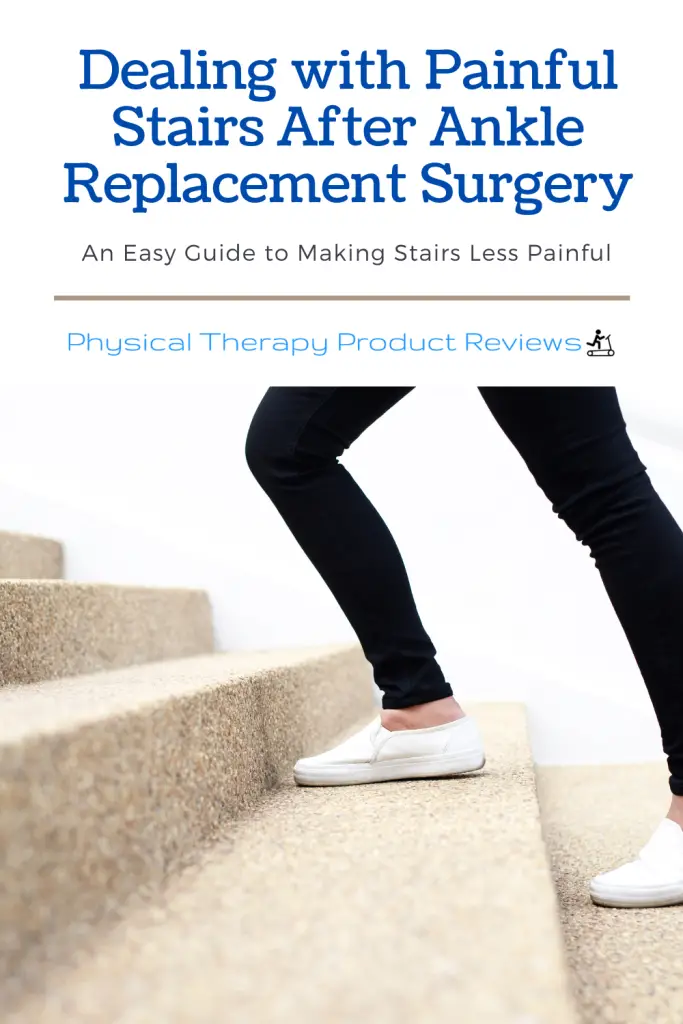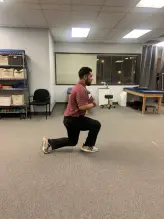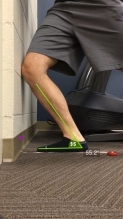After undergoing an ankle replacement surgery, patients may experience pain when climbing stairs. The level of pain can vary from mild discomfort to severe pain, depending on the individual’s pain tolerance and the extent of the surgery.
The pain with stairs after an ankle replacement can be a significant challenge for patients during recovery. It can limit their mobility and make it difficult to perform daily activities that require climbing stairs at home or work. This can be frustrating and discouraging for patients who are eager to regain their independence and return to their normal routines.

Can you imagine being scared of stairs for the rest of your life? That would be brutal.
Fortunately, there are several strategies that can help manage pain with stairs after an ankle replacement. These may include physical therapy exercises that improve range of motion and strength, bracing, and modifications to the patient’s environment to reduce the need for stairs. By working closely with their healthcare team and following a customized recovery plan, patients can minimize pain and achieve a successful outcome after ankle replacement surgery.
Understanding Ankle Replacement Surgery
The Procedure
Ankle replacement surgery, also known as ankle arthroplasty, is a surgical procedure that involves replacing a damaged ankle joint with an artificial implant. The procedure is typically performed under general anesthesia and takes about two hours to complete.
During the procedure, the surgeon will make an incision in the ankle and remove the damaged parts of the joint. The artificial implant is then inserted into the ankle, and the incision is closed with sutures. Several types of ankle replacement implants are available, including those made of metal, plastic, or a combination of both. The type of implant used will depend on the patient’s age, weight, and activity level.
Recovery
Recovery after ankle replacement surgery can take several months. During rehab, the patient will need to learn how to walk normally again after an ankle replacement, improve their strength, and return to their normal levels of activity.
Physical therapy is an important part of the recovery process after ankle replacement surgery. This includes working to regain strength and mobility in the ankle. Exercises may include range of motion exercises, stretching, and strengthening exercises.
One common issue that patients may experience after ankle replacement surgery is pain with stairs. This is due to two main reasons:
1.) The ankle joint is responsible for absorbing the impact of each step taken on stairs. This takes considerable strength to tolerate those high loads.
2.) The ankle doesn’t have enough flexibility to bend enough when descending stairs.
It is important for patients to learn proper techniques for going up and down stairs to avoid exacerbating this pain.
Ankle replacement surgery can be an effective treatment option for patients with severe ankle arthritis. However, it is important for patients to have realistic expectations about the recovery process and to follow their surgeon’s and physical therapist’s instructions closely to achieve the best possible outcome.
Common Complaints After Ankle Replacement Surgery
Pain with Stairs
After an ankle replacement surgery, patients may experience pain with stairs. Patients may also experience pain with other weight-bearing activities, such as walking or standing for long periods of time. Physical therapy-guided exercises, such as stretching, strengthening, and other pain management techniques, can help alleviate this discomfort.
Swelling
Swelling is also a common complication after surgery. It’s typically the most severe immediately after the surgery but should improve gradually over time. It can also reoccur with various amounts throughout the recovery process. Swelling can cause discomfort and limit ankle mobility. Compression stockings and elevation can help reduce swelling.
Patients should also avoid standing or sitting for extended periods of time and should focus on light, comfortable movement, such as walking, to push swelling out of the leg.
Bruising
Bruising is another common complication after ankle replacement surgery. It can occur at the incision site or in other areas of the foot and ankle. Patients should apply light pressure on the affected area to push the bruising out and also try kinesio tape to help speed up the reduction of bruising.
Overall, ankle replacement surgery is a successful procedure with a high rate of patient satisfaction. However, as with any surgery, common complaints can arise.
Causes of Pain with Stairs After Ankle Replacement Surgery
Weakness
One of the causes of pain with stairs after ankle replacement surgery is weakness in the muscles surrounding the ankle joint. The surgery can weaken these muscles, but it’s further exacerbated by the immobilization required during recovery, which really causes extreme weakness. When patients are in the walking boot for weeks on end, the muscles start to atrophy quickly.
Weakness can make climbing stairs difficult, as lifting the body weight with each step requires more effort and more strength. The weak muscle place extra strain on the healthy muscle to complete a stair.
Lack of Range of Motion
Another cause of pain with stairs after ankle replacement surgery is a lack of range of motion in the ankle joint. The surgery can cause joint stiffness, making it difficult to flex the ankle enough to climb stairs. While descending stairs, most ankles need around 9-10 degrees of ankle dorsiflexion range of motion which can take a while to achieve after surgery.
Mechanical Issues
Finally, mechanical issues with ankle replacement can also cause pain with stairs. If the replacement joint is not aligned properly, it can cause abnormal wear and tear on the joint and surrounding tissues. This can lead to pain and discomfort, especially when climbing stairs or performing other weight-bearing activities.
This is extremely rare and is easily checked with a post-op x-ray.
Treatment Options for Pain with Stairs After Ankle Replacement Surgery
Strengthening Exercises for the Ankle Replacement
Physical therapy is essential to the recovery process after ankle replacement surgery. Strengthening exercises for the ankle can help alleviate pain and improve mobility. These exercises can include but are not limited to the following:
- Heel raises: Stand with your feet shoulder-width apart, slowly raise your heels off the ground, then lower them back down. Repeat 10-15 times and perform 3 sets.
- Inline Partial Lunge: Perform walking partial lunges with your front heel close to your back knee. Focus on bending at the ankle and getting a good push from the surgical ankle with each step. You may need to hold on to a counter or chair for balance.
- Resistance band exercises: Place a strong resistance band around your foot and gently flex your foot up and down against the band’s resistance, almost like you are pushing down into a gas pedal. Repeat 10-15 times for 3 sets.

Exercises to Improve Range of Motion
Stiffness and limited range of motion are common after ankle replacement surgery. However, exercises that focus on improving the range of motion can help alleviate pain and improve mobility. These exercises can include:
- Ankle pumps: Sit on a chair and lift your foot off the ground. Slowly flex and extend your ankle, moving your foot up and down. Repeat 10-15 times.
- Knee-to-Wall Ankle Mobility: Stand facing a wall and place your foot with the ankle you wish to mobilize in front, ensuring your toes point straight ahead. Slowly bend your knee and press it into the wall until you feel a stretch in your calf muscle and the front of the ankle joint. Hold this position for 10-15 seconds before releasing the pressure and straightening your knee. Perform 15 reps and hold for 10 seconds, 4 days a week.
- Stretching exercises: Sit on a chair and use a towel to stretch your ankle in different directions gently. In particular, try to stretch the calf by pulling the foot towards your shin. Hold each stretch for 30-45 seconds.

It is important to remember that both stretching and strengthening exercises take time to make a noticeable change.
Try Using a Compression Sleeve
Ankle compression sleeves are designed to support and stabilize the ankle joint. They are made of a stretchy material that fits snugly around the ankle, providing compression and support and thus reducing pain and swelling during their use.
Click For Our Favorite Ankle Compression Sleeve
The sleeve also helps to improve proprioception, which is the ability to sense the position and movement of the ankle joint. This is important when navigating stairs, as it helps patients to maintain their balance and avoid falls. In addition, ankle compression sleeves can help reduce swelling and inflammation, making it easier for patients to move around and navigate stairs with less pain and discomfort.
Be patient and be diligent about performing about every other day. It’s ok to push into discomfort but don’t push into pain.
Preventing Pain with Stairs After Ankle Replacement Surgery
Stair climbing can be challenging after surgery, which many people take for granted. However, with proper care and planning, patients can minimize the pain and discomfort associated with stairs. Here are some tips to prevent pain with stairs after ankle replacement surgery:
- Use crutches or a walker to support the weight of the body while climbing stairs immediately after surgery.
- Take one step at a time and avoid rushing up or down the stairs.
- Try going up and down stairs sideways to limit the required bending of the ankle.
- Place the entire foot on each step while climbing up or down the stairs. Avoid placing only the toes or heels on the steps.
- Use the handrail for support while climbing up or down the stairs.
- Avoid carrying heavy objects while climbing stairs.
Physical therapy exercises can help patients regain strength and mobility in their ankles and reduce pain with stairs.
Overall, patients should take their time and be patient while climbing stairs after ankle replacement surgery.
Conclusion
Overall, pain with stairs after an ankle replacement is a common issue that patients may experience during their recovery. However, with proper physical therapy and rehabilitation, patients can work to improve their gait and reduce pain while ascending stairs.
While there may be some limitations or adjustments needed in the early stages of recovery, most patients are able to return to their normal activities within a few months after surgery.
Latest Posts
- GLP Weight Loss and Back Health: Effective Strategies and Insights
- How to Stay Active After Cervical Fractures: Expert Tips and Advice
- Dealing with Painful Stairs After Ankle Replacement Surgery
- Walking After a Total Ankle Replacement: Tips for a Successful Recovery
- Exercises While Non-Weight Bearing After Ankle Replacement: Elevation, AROM, Leg Raises, and More
Disclaimer: The information provided in this post is for educational purposes only. This is not a substitute for a medical appointment. Please refer to your physician before starting any exercise program.

